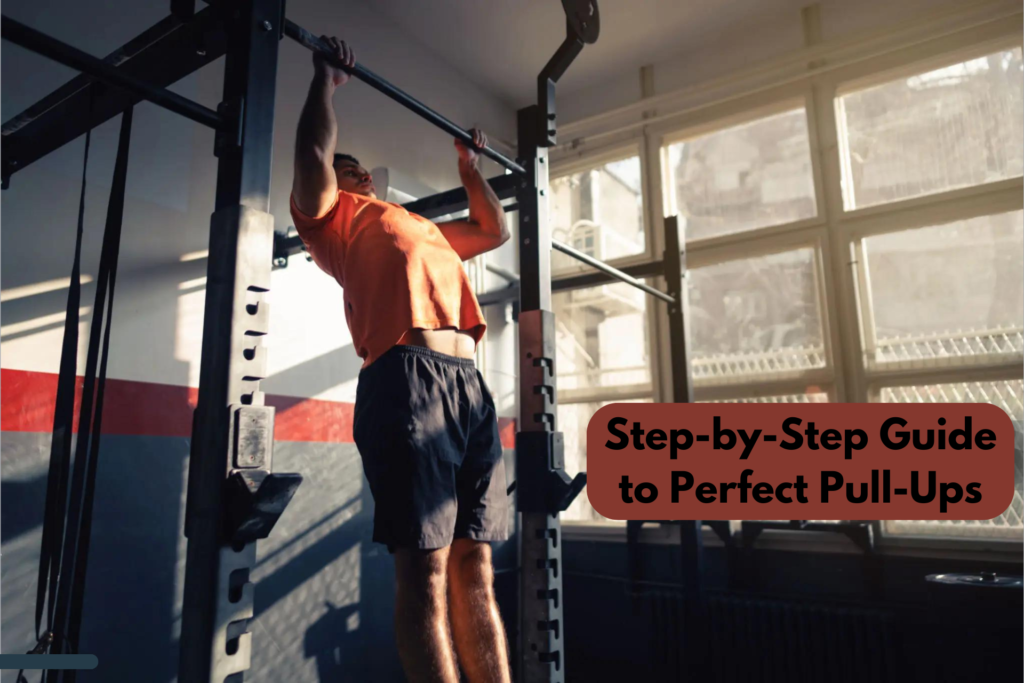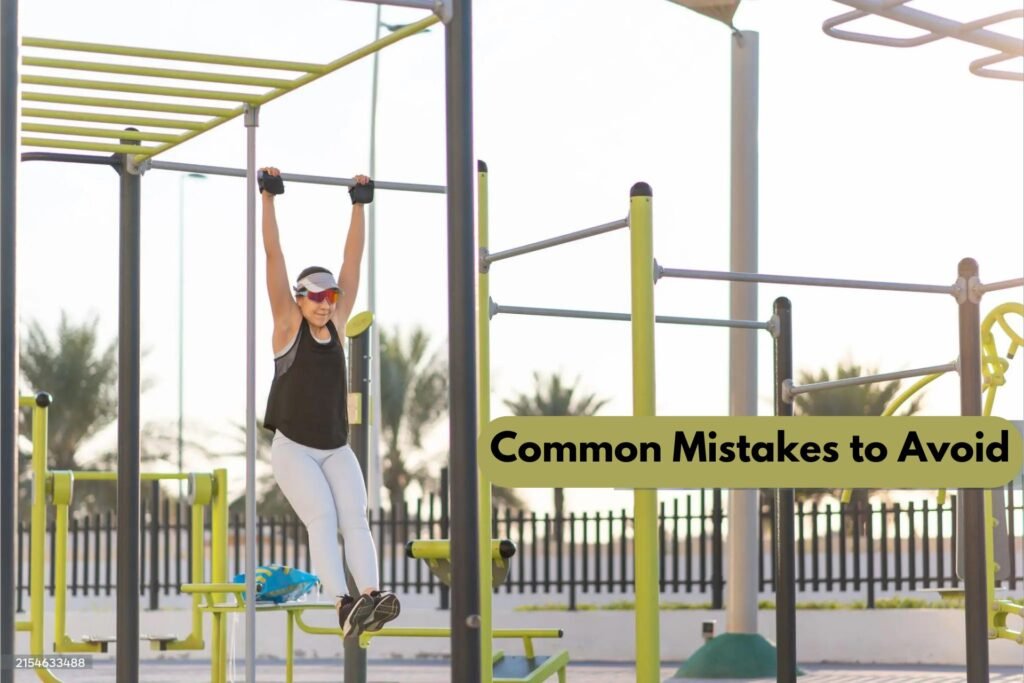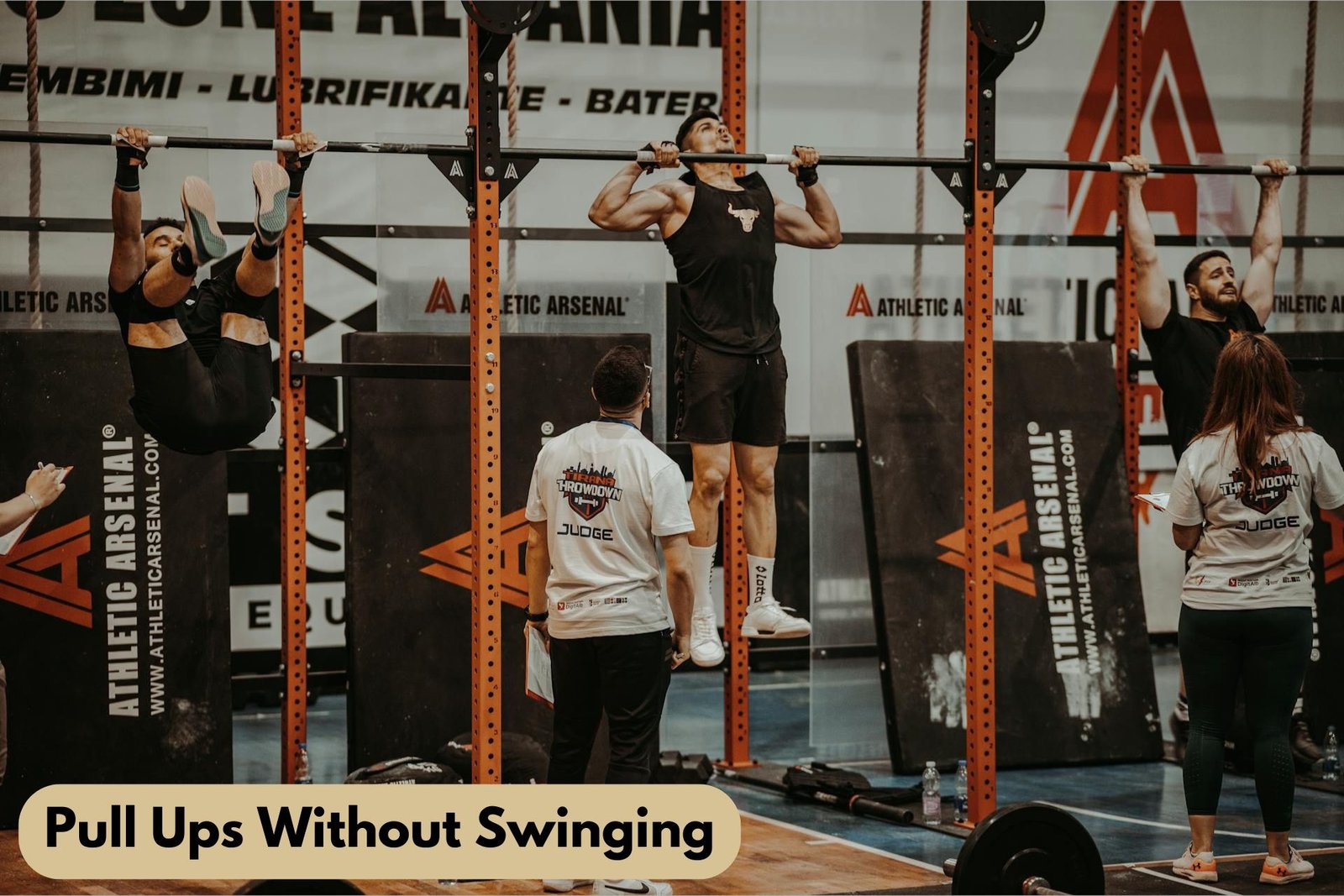Have you ever thought about how to master pull ups without swinging?
It’s a common challenge that many fitness enthusiasts face.
Key Takeaways
- Control movements to prevent momentum and maximize muscle engagement
- Maintain proper form with correct grip, arm positioning, and core engagement
- Execute each pull-up from a dead-hang, focusing on control throughout
- Incorporate beginner-friendly stability and resistance exercises to build strength
- Progress to advanced variations as you improve
- Prioritize rest, nutrition, and hydration for effective muscle recovery
Introduction: Mastering the Art of Pull Ups without Swinging
Pull-ups are the crown jewel of bodyweight exercises, but nailing them without swinging? That’s where the real magic happens.
As a calisthenics freak with a decade of coaching under my belt, I’ve seen countless people struggle with this.
But here’s the thing: swingless pull ups aren’t just about looking good at the gym.
They’re about building raw, functional strength that’ll serve you in every aspect of life.
Understanding Common Pull-Up Mistakes
A. Using momentum instead of muscle strength
Picture this: you’re at the park, eyeing that pull-up bar like it’s your mortal enemy.
You jump up, grab on, and start swinging like a pendulum on steroids.
Sure, you might get your chin over the bar, but are you really doing a pull-up?
Spoiler alert: you’re not.
You’re cheating yourself out of gains, my friend.
B. Swinging legs during the exercise
Your legs aren’t just along for the ride.
They’re like a bull in a china shop, wreaking havoc on your form.
When your legs start swinging, it’s like opening Pandora’s box of momentum.
Suddenly, you’re relying on physics instead of your lats.
Not cool, bro. Not cool at all.
C. Incorrect grip and arm positioning
Grip that bar like your life depends on it, but don’t strangle it.
Your hands should be just wider than shoulder-width apart.
Thumbs wrapped around or not? That’s your call.
But whatever you do, don’t let those elbows flare out like you’re trying to take flight.
Keep ’em tucked and pointed towards your feet.
D. Neglecting core engagement
Your core isn’t just for impressing people at the beach.
It’s the powerhouse of your pull-up.
Forget to engage it, and you’ll be flopping around like a fish out of water.
Tighten that midsection like you’re bracing for a punch.
Your pull-ups will thank you.
Step-by-Step Guide to Perfect Pull-Ups

A. Proper starting position (dead-hang)
Let’s start from the ground up, or rather, from the hang down.
The dead-hang is your launchpad to pull-up perfection.
Arms fully extended, shoulders activated, core tight.
You’re not just hanging there like a sack of potatoes.
You’re coiled, ready to explode upwards.
B. Engaging the core for stability
Imagine you’ve got a belt of steel wrapped around your midsection.
That’s how tight your core should be.
It’s not just about looking good in a crop top.
It’s about creating a solid foundation for your pull-up.
No wiggling, no swaying, just pure, controlled power.
C. Controlled upward movement
Now, here’s where the rubber meets the road.
As you pull yourself up, think about squeezing your shoulder blades together.
Imagine you’re trying to crush a walnut between them.
Your elbows should be driving down towards your hips, not flaring out like chicken wings.
It’s a smooth, controlled ascent. No jerking, no sudden movements.
Just you versus gravity in an epic showdown.
D. Maintaining form at the top of the movement
Congratulations, you’ve made it to the top!
But don’t celebrate just yet.
Hold that position for a hot second.
Your chin should be over the bar, not just barely grazing it.
Keep those shoulders down and back, core tight.
You’re not done until you’ve savored this moment of triumph.
E. Slow, controlled descent
What goes up must come down but on your terms.
The descent is just as important as the ascent.
Lower yourself with the grace of a ballet dancer and the control of a gymnast.
Fight gravity every inch of the way down.
This is where the real muscle-building happens.
Embrace the burn, my friend.
Pro Tip:
Don’t forget the cool-down – it’s not just a formality, it’s your ticket to faster recovery and reduced soreness.
Beginner-Friendly Techniques
1. Using a bench or chair for foot stabilization
Can’t quite nail that perfect pull up yet? No worries, we’ve all been there.
Grab a bench or a chair and place it in front of you.
Rest your feet lightly on it as you perform your pull-ups.
It’s like training wheels for your upper body.
As you get stronger, gradually reduce the support until you’re flying solo.
2. Negative pull-ups for building strength
Negative pull ups are the unsung heroes of pull-up training.
Jump up to the top position and lower yourself as slowly as possible.
It’s like doing pull-ups in reverse, and it’s brutally effective.
Your muscles are stronger in the eccentric (lowering) phase.
Exploit this fact to build the strength you need for full pull ups.
3. Assisted pull-ups with resistance bands
Resistance bands and Assisted pull ups are your new best friend.
Loop one over the bar and place your foot or knee in it.
It’s like having a spotter giving you a boost.
Start with a thicker band and progress to thinner ones as you get stronger.
Before you know it, you’ll be ditching the bands altogether.
4. Core stability exercises to support proper form
Your core and stability exercises are the unsung hero of the perfect pull up.
Planks, hollow body holds, and hanging leg raises are your secret weapons.
They’ll build the stability you need to keep your body rigid during pull ups.
Think of it as building your foundation before constructing your pull-up skyscraper.
Pro Tip:
Start light and progress slowly – this isn’t a sprint, it’s a marathon of strength building.
Advanced Techniques and Variations
A. Slow pull-ups for increased muscle engagement
Want to take your pull-ups to the next level? Slow things down.
I’m talking glacier-slow.
Aim for a 5-second ascent and a 5-second descent.
You’ll feel every muscle fiber screaming in protest, but that’s where the magic happens.
It’s like turning your pull up into a slow-motion ballet of strength.
B. L-sit pull-ups for core and upper body synergy
Imagine your legs are fused at a 90-degree angle to your torso. Now do a pull up.
Sounds impossible? Welcome to the world of L-sit pull-ups.
This variation is like a symphony of muscle activation, where your core and upper body harmonize in a crescendo of power.
It’s as much a test of your mental fortitude as it is of your physical strength.
C. One-arm pull-up progression
The one-arm pull up is the Holy Grail of bodyweight exercises. It’s like trying to climb a glass wall with one hand – seemingly impossible, yet tantalizing in its challenge.
Start with assisted one-arm negatives, feeling the strain ripple through your arm like a wave of molten lava.
Progress to archer pull-ups, where one arm does the heavy lifting while the other plays a supporting role.
It’s a journey of patience and persistence, but the payoff is worth its weight in gold.
D. Weighted pull-ups for increased strength
When bodyweight becomes too easy (yes, it happens), it’s time to strap on some extra poundage.
Weighted pull-ups are like adding rocket fuel to your strength gains.
The added resistance turns each rep into a herculean effort, forcing your muscles to adapt or be left behind.
Common Mistakes to Avoid

A. Overtraining and not allowing proper recovery
In the pursuit of pull-up perfection, it’s easy to fall into the trap of overtraining.
Your muscles aren’t forged in the gym; they’re sculpted in your sleep.
Give your body the rest it deserves. It’s during these periods of recovery that your muscles knit themselves back together, stronger than before.
Ignore this advice at your peril – overtraining is like trying to drive a car with no gas.
B. Neglecting proper warm-up and cool-down routines
Skipping your warm-up is like trying to run a marathon right out of bed.
Your muscles need to be coaxed into action, like waking a sleeping giant.
A proper warm-up routine primes your body for the task ahead, reducing the risk of injury and improving performance.
C. Focusing solely on pull-ups and neglecting overall upper body development
Pull-ups are fantastic, but they’re not the be-all and end-all of upper body training.
Neglecting other exercises is like trying to build a house with only a hammer.
Incorporate push-ups, rows, and overhead presses into your routine.
This balanced approach will not only improve your strength but also build a more aesthetically pleasing and functionally strong upper body.
To learn more about the common mistakes, check here.
Nutrition and Recovery for Optimal Performance
A. Proper protein intake for muscle repair and growth
Your muscles are hungry beasts, and they crave protein.
Think of protein as the building blocks of your muscles – without it, you’re trying to build a brick house with no bricks.
Aim for about 1.6 to 2.2 grams of protein per kilogram of body weight daily.
Spread it out over your meals, giving your body a steady supply of amino acids to work with.
B. Importance of hydration in muscle function
Water isn’t just for quenching thirst – it’s the lifeblood of your muscles.
Dehydration can turn your muscles into a barren wasteland, sapping your strength and stamina.
Keep a water bottle handy and sip throughout the day.
Your muscles will thank you with improved performance and faster recovery.
C. Role of sleep in muscle recovery and strength gains
Sleep isn’t just a luxury; it’s a necessity for anyone serious about strength gains.
It’s during those precious hours of shut-eye that your body goes into overdrive, repairing and rebuilding your muscles.
Skimp on sleep, and you’re robbing yourself of gains. Aim for 7-9 hours per night, and watch your pull-up numbers soar.
Conclusion
Mastering swingless pull-ups is a journey, not a destination. It’s a test of patience, perseverance, and sheer grit.
But the rewards are worth every drop of sweat. With proper form, consistent practice, and a dash of determination, you’ll be cranking out perfect pull-ups in no time.
Remember, every rep is a step towards your ultimate goal.
Embrace the challenge, relish the struggle, and watch as your body transforms into a pull-up powerhouse.
FAQs
How many pull-ups should I be able to do?
There’s no one-size-fits-all answer. Focus on proper form and gradual improvement rather than hitting a specific number.
Can I do pull-ups every day?
While consistency is key, your muscles need time to recover. Aim for 2-3 pull-up sessions per week, allowing rest days in between.
Why are my pull-ups not improving?
Common reasons include inadequate rest, poor nutrition, or improper form. Reassess your routine and make adjustments as needed.
Are pull-ups better than lat pulldowns?
Both have their merits, but pull-ups generally offer more bang for your buck in terms of overall muscle engagement and functional strength.
How can I increase my pull-up reps?
Progressive overload is key. Gradually increase volume, add weight, or try more challenging variations to keep pushing your limits.
Don’t Forget to Squeeze as your muscles owe you money!

